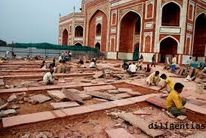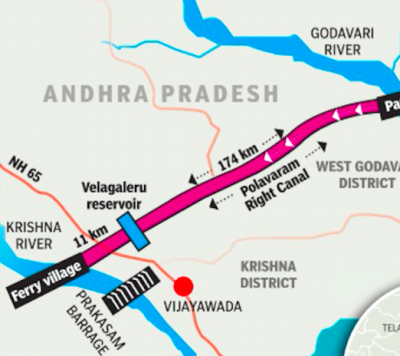Polavaram National Irrigation Project 30/04/2019 – Posted in: Daily News
Polavaram National Irrigation Project
For: Preliminary; Mains: GS I, III
Topics covered: Economic Development, About Polavaram National Irrigation projects, Geographical location, Concerns (Environmental), Advantages and disadvantages, Tribal’s displacement
News Flash
Few cracks were found on land at the Polavaram National Irrigation Project site. These cracks are known as Earth fissures.
What causes Earth fissures?
Earth fissures are substantial splits in the ground. They are framed because of soil surface tension due to land subsidence (lowering down of the ground surface elevation).
Land subsidence is predominantly caused by groundwater siphoning or groundwater pumping. This causes tension at the soil’s surface which results in the formation of a split or crack.
Background
During 19th century, the Polavaram National Irrigation Project was convinced by Sir Arthur Cotton under the National River Interlinking project. The project also gain support from Godavari Water Disputes Tribunal. Foundations of the project were laid down in 1980. Project gets green signal in 2004 and it was declared as a national Project.
Location
The multi-purpose under-construction irrigation project is on the Godavari River in the West Godavari District and East Godavari District in Andhra Pradesh. Its reservoir spreads into parts of Chhattisgarh and Odisha States also.
Purpose
- The project was designed to overcome the deficit in water in the country.
- The project also endeavours to develop irrigation, drinking water facilities and hydropower to regions of East Godavari, Vishakhapatnam, Krishna and West Godavari districts of Andhra Pradesh.
- The earth and rock filled dam will have a capacity limit of 551 million cubic meter (mcm) and power generation capacity of 960 MW.
- The water from the dam reservoir will irrigate 291,778 ha of agricultural land in the districts of Krishna, East and West Godavari and Visakhaptnam through two major canals.
How
Under this project, the surplus water from Godavari basin seeks to transfer to Krishna river basin that is a water deficit. This exercise took place by networking 30 rivers links together with a total length of 14,900 kilometers. The ongoing project would be the largest ever infrastructure project in the world.
Pros and Cons
In this project’s case, the Godavari river basin is considered as a surplus one, while the Krishna River basin is considered to be a deficit one.
Opposition of Project
- Polavaram project was opposed on the ground that it would amount to the displacement of nearly 300 villages (including 50% tribal populations)
- Distance Displacement is a noteworthy reason for embitterment among local people and this makes fertile conditions for spread of insurgency.
- Some environmental activists argue that the project will submerge forests and wildlife sanctuaries.
- The project may also impact inland fishing. (important source of livelihood for the people)
- The project is too costly.
- The Polavaram project will harness the waters of the river Godavari by building a 45.72- metre-high, 2.32-km-long dam.
- The dam will submerge 276 villages in Andhra Pradesh’s Khammam and East and West Godavari districts, Odisha’s Malkangiri district, and Chattisgarh’s Dantewada district, up to a distance of 150 km
Source: The Hindu
You can follow us on LinkedIn and for more updates related to UPSC IAS Preparation, Like our Facebook Page and subscribe our Diligent IAS Youtube Channel
Also Read Related Daily News






